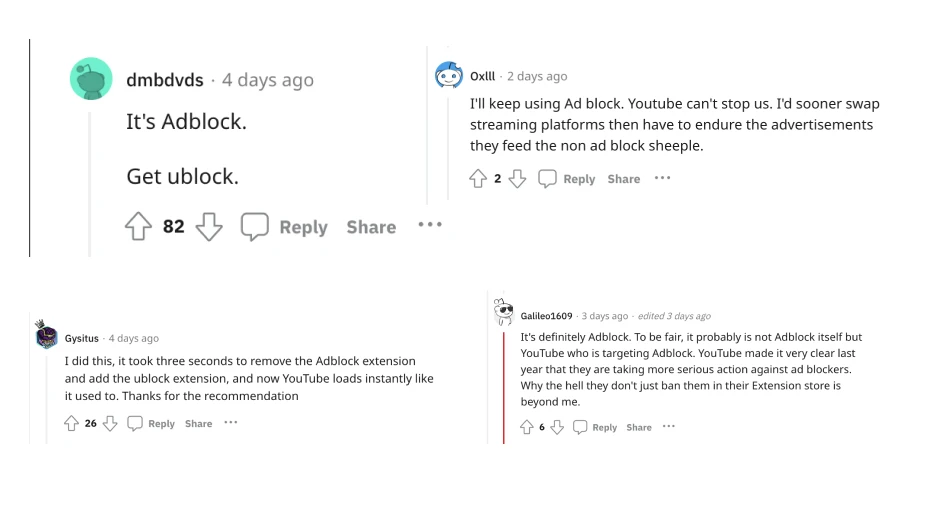The prevalence of online advertisements on platforms such as YouTube has led many users to seek refuge in adblockers, browser extensions that block ads from appearing during browsing activities. These tools have gained popularity due to the annoyance caused by intrusive video ads and banners.
The Current Slowdown
As users navigate through YouTube, they may notice a distinctly slower browsing experience, with delays occurring even for simple actions like clicking on videos or switching between channels. This slowdown is not limited to specific videos or channels but rather affects a wide range of content, creating frustration among users seeking a seamless browsing experience.
A closer examination reveals that users across different devices, browsers, and network settings are facing the same issue, indicating a widespread problem that surpasses individual user configurations. The impact of the slowdown has been felt by users worldwide, raising concerns about YouTube’s network performance.
YouTube Slowdown with Adblock
It seems that a significant factor contributing to the slowdown is AdBlock. Users who rely on adblockers browser extensions notice a distinct delay in video playback and browsing activities, as YouTube’s server attempts to bypass adblocker restrictions. These deliberate slowdown tactics have raised concerns among users who expect a smoother, uninterrupted browsing experience.
The recent slowdown on YouTube encompasses various aspects, including website traffic, browsing behavior, adblocker usage, and the display of YouTube videos. The slowdown affects website traffic, resulting in slower loading times and delays when navigating the platform. Users, regardless of their browsing habits or settings, are experiencing these issues, indicating that the slowdown is not isolated to specific user configurations.
User Experiences and Complaints
Users have taken to social media, forums, and Reddit accounts to express their frustration over the recurring delays while browsing YouTube. The slowdown’s persistent nature has prompted users to voice their concerns, seeking solutions to restore the smooth browsing experience they once enjoyed. Despite attempts to adjust browser settings or network policies, users find that the impact of the slowdown remains evident, causing dissatisfaction among those who rely on YouTube for entertainment, education, and other purposes.

The Role of AdBlock in the Slowdown
While adblockers provide users with the ability to block video ads and banners, these extensions inadvertently contribute to the current slowdown on YouTube. Adblockers function by preventing video ads from being displayed during browsing activities, significantly improving the browsing experience for users. However, in response to adblocker usage, YouTube devised tactics to intentionally slow down website traffic for users relying on these ad-blocking tools.
This strategic move aims to encourage users to disable adblockers and view more ads, thus restoring YouTube’s ad revenue streams. The escalating adblocker usage poses challenges to YouTube’s advertising revenue model, prompting the platform to target adblocker users to address potential revenue implications.
The Mechanism of AdBlockers
Adblockers, browser extensions designed to block ads from appearing during browsing activities, operate through a series of functions and settings. The mechanisms behind adblocker operation include:
- Adblock browser extensions work by scanning website content, identifying code associated with ads, and preventing their display.
- Browser settings can be adjusted to block certain types of ads, banners, and video ads.
- Adblockers also safeguard users by blocking malware and malicious ads that may compromise browsing security.
- Users can customize adblocker settings, selecting preferences such as adblocker strength, whitelisted websites, and ad-blocking exceptions, depending on their browsing habits.
- These adblocker mechanisms ensure a smoother browsing experience, maximizing user control, ad-free browsing, and protection against potentially harmful ads. However, the escalating adoption and effectiveness of adblocker technology have prompted YouTube to address the impact on its ad-reliant revenue model, leading to deliberate tactics to affect the browsing experience of adblocker users.
Why YouTube Targets AdBlock Users
By intentionally slowing down website traffic and implementing network policy changes, YouTube raises awareness of the impact adblocker usage has on its advertising ecosystem. The measures taken by YouTube aim to address ad display limitations and ensure advertisers are able to reach their target audience effectively. Maintaining ad revenue streams remains a priority for YouTube, necessitating the targeting of adblocker users to address potential revenue implications.
YouTube, as a renowned platform for advertisers, relies on ad revenue to sustain itself and support content creators. Advertisements, including video ads, banners, and more, generate revenue streams necessary for YouTube’s sustained growth and development. However, the widespread adoption of adblocker tools disrupts this revenue model, prompting YouTube to actively target adblocker users.
Ad Revenue vs. User Experience
YouTube, like any other online platform, faces the challenge of balancing ad revenue with user experience. While ads serve as a vital source of revenue for YouTube, the browsing experience and satisfaction of its users remain essential considerations. YouTube recognizes the importance of optimizing ad placement, frequency, and relevance to strike a delicate balance between profitability and user satisfaction.
The platform’s response to adblocker usage reflects its commitment to enhancing user experience without compromising revenue streams. By addressing adblocker-related browsing restrictions, YouTube aims to maintain ad revenue while minimizing the impact on users who prefer ad-free browsing. The evolving landscape of adblocker technology necessitates a strategic approach to achieving the harmony between profit and user satisfaction that YouTube strives to fulfil.
The Importance of Ads for YouTube’s Revenue
Advertisements are of utmost importance to YouTube’s revenue model. As a Google-owned platform, YouTube generates a significant portion of its revenue through ads. The presence of video ads not only benefits YouTube but also aids content creators, contributing to the economic viability of the platform.
Balancing Profit and User Satisfaction
Maintaining a balance between profit and user satisfaction is a core challenge for YouTube. While ad revenue remains integral to its sustainability, user experience plays a pivotal role in ensuring user retention and satisfaction. YouTube recognizes the growing popularity of adblocker usage among its users, which highlights the need to address their browsing preferences without jeopardizing ad revenue streams.

The Impact on Users
The deliberate slowdown and targeting of adblocker users on YouTube have presented users with a difficult choice. Users are now compelled to decide whether to remove their adblocker extensions and face an increase in unwanted ads or explore alternative options that offer ad-free browsing experiences.
Both choices have their pros and cons, and users must weigh their browsing preferences, browsing habits, and tolerance towards ads before making a decision.
Removing AdBlock Extensions: Pros and Cons
Removing adblocker extensions, while enabling users to access ad-supported content seamlessly, does have its drawbacks. Consider the following pros and cons of removing adblocker extensions:
- Pros:
- Improved browsing experience, with website traffic flowing smoothly and videos loading without delays.
- Enhanced compatibility, as some websites may be inaccessible or display improperly when adblocker extensions are enabled.
- Consistent default settings, ensuring that users do not unintentionally miss out on any website features or content.
- Cons:
- An influx of unwanted ads, banners, and video ads, which can be intrusive and disruptive to the browsing experience.
- Decreased browsing speed, as each ad requires additional loading time, resulting in a slower and less streamlined browsing experience.
- Potential exposure to malicious ads, malware, or phishing attempts, as adblocker extensions act as a safeguard against such threats.
- Considering these pros and cons, users must evaluate their browsing priorities, convenience, and level of tolerance towards ads before deciding to remove adblocker extensions.
Is Youtube Premium Worth It?
For users seeking an ad-free browsing experience, YouTube Premium offers a viable solution. By subscribing to YouTube Premium, users can enjoy ad-free access to YouTube videos, music, and other exclusive content. However, the decision to opt for YouTube Premium comes with considerations, including its worth and value:
- YouTube Premium provides an ad-free experience on videos, ensuring uninterrupted streaming and browsing.
- The subscription includes additional benefits, such as background play, offline downloads, and access to YouTube Originals.
- Cost is a determining factor, as users must weigh the benefits of ad-free browsing against the subscription price of YouTube Premium.
- The switch to YouTube Premium may require users to adjust network policy settings, preferences, and browsing habits.
- Ultimately, the decision to subscribe to YouTube Premium depends on individual preferences, the value placed on ad-free viewing, and the importance of additional features offered by the premium subscription.
Public Opinion on YouTube’s Tactics
YouTube’s deliberate tactics to deter adblocker usage have sparked public opinion and generated conversations across social media platforms and online communities. As users experience the impact of the slowdown and targeted measures, reactions range from frustration and discontent to understanding and acknowledgement of YouTube’s ad revenue concerns.
The Ethical Debate: Is YouTube’s Approach Justified?
YouTube’s approach to addressing adblocker usage has ignited an ethical debate among users, industry professionals, and online communities. The debate revolves around the following key points:
- Network policy changes: Users question the ethics of intentionally slowing down website traffic to discourage adblocker usage, as it impacts the browsing experience and user satisfaction.
- User privacy and choice: The deliberate targeting of adblocker users sparks discussions on the ethics of controlling users’ browsing preferences and infringing on their right to choose ad-free browsing.
- Revenue vs. user experience: The ethical implications of prioritizing ad revenue over user experience become a focal point, with arguments made for striking a balance that respects both revenue streams and user satisfaction.
- Impact on content creators: The debate acknowledges the significance of ads in supporting content creators and facilitating their ability to generate revenue, prompting discussions on the sustainability of ad-supported platforms.
The ethical landscape surrounding YouTube’s approach remains complex, with differing viewpoints and perspectives influencing the ongoing conversation.
Alternatives to YouTube
As users navigate the adblocker controversy on YouTube, alternative video sharing platforms will now emerge as possibilities for ad-free browsing experiences. Platforms like Vimeo and others offer users an option to explore video content without the intrusion of video ads, banners, and other ad-related disruptions.
Pros and Cons
Exploring alternative video sharing platforms offers users the following pros and cons:
- Pros:
- Ad-free browsing: Alternative platforms often provide ad-free browsing experiences, allowing users to enjoy video content without interruptions.
- Reduced video ads: Some video sharing platforms implement fewer video ads, striking a balance between ad revenue and user experience.
- Diverse content: Alternative platforms offer a variety of video content, sometimes catering to specific niches, expanding options for users seeking specific topics or genres.
- Cons:
- Limited content availability: The breadth and depth of content on alternative platforms may not match YouTube’s extensive collection, potentially limiting users’ content options.
- Platform familiarity: Moving away from YouTube requires adapting to a new platform’s interface, browsing features, and settings, which may require an adjustment period.
- Popularity and user base: The reach and active user base of alternative video sharing platforms may vary, potentially affecting the availability of in-depth discussions, interactions, and community engagement.
- When considering these pros and cons, users must evaluate their browsing priorities, content preferences, and the value placed on ad-free browsing to determine the most suitable alternative video sharing platform.
Making the Switch
User testimonials play a crucial role in shaping perceptions and guiding the decision-making process regarding the switch to ad-free video sharing platforms. As users navigate the adblocker controversy, social media becomes a platform for sharing personal experiences, garnering insights, and providing user testimonials. These testimonials offer a glimpse into the browsing habits, user experiences, and satisfaction levels of those who have made the switch so keep a look out for comments and reviews of the situation on Reddit, Twitter and others!
What Happens Now?
Could the current adblocker controversy surrounding YouTube raise questions about a possible ad-free internet revolution? As more users embrace adblocker tools, the impact on website traffic and ad revenue becomes increasingly significant. If this trend continues, it could potentially shift the dynamics of online advertising, forcing platforms and advertisers to adapt to a new reality. Users seeking an ad-free browsing experience are likely to explore alternative platforms or demand ad-free options, shaping the future of online content consumption.
Conclusion
In conclusion, the issue of YouTube’s slowdown for AdBlock users raises important questions about the balance between ad revenue and user experience. While ads are crucial for YouTube’s revenue, it is essential to find a middle ground that prioritizes user satisfaction. Users are forced to choose between removing AdBlock extensions or opting for YouTube Premium, both of which have pros and cons.
Public opinion on YouTube’s tactics is divided, with some users expressing frustration and others understanding the need for ads. Exploring alternative video sharing platforms is also an option for users looking for a lag-free experience. Ultimately, this situation sparks discussions about the future of an ad-free internet and the ethical implications of YouTube’s approach.
Frequently Asked Questions
Why is YouTube so slow with Adblock?
YouTube’s slow performance with adblock is intentional, aiming to discourage users from using adblockers. Ads generate revenue for YouTube and content creators, so they prioritize showing ads to users. Some adblockers disrupt YouTube’s algorithms, resulting in slower loading times. Users can choose to watch ads or support content creators directly instead of relying on adblockers.
Is YouTube slowing down?
YouTube’s Slowdown is not a result of the platform itself slowing down. It refers to the deliberate slowing down of videos for users with AdBlock enabled. This strategy is aimed at encouraging users to disable AdBlock and view more ads, although it has faced criticism from users who feel it negatively impacts their viewing experience.
Is YouTube slow/lagging for anyone else?
Experiencing slow or lagging issues on YouTube? You’re not alone. Various factors, such as internet speed and device performance, can contribute to these problems. Try clearing your browser cache and cookies or updating your browser to improve YouTube’s performance. If the issues persist, it could be due to the recent attack on adblockers. Try deactivating your adblocker and it should now run smoothly.

